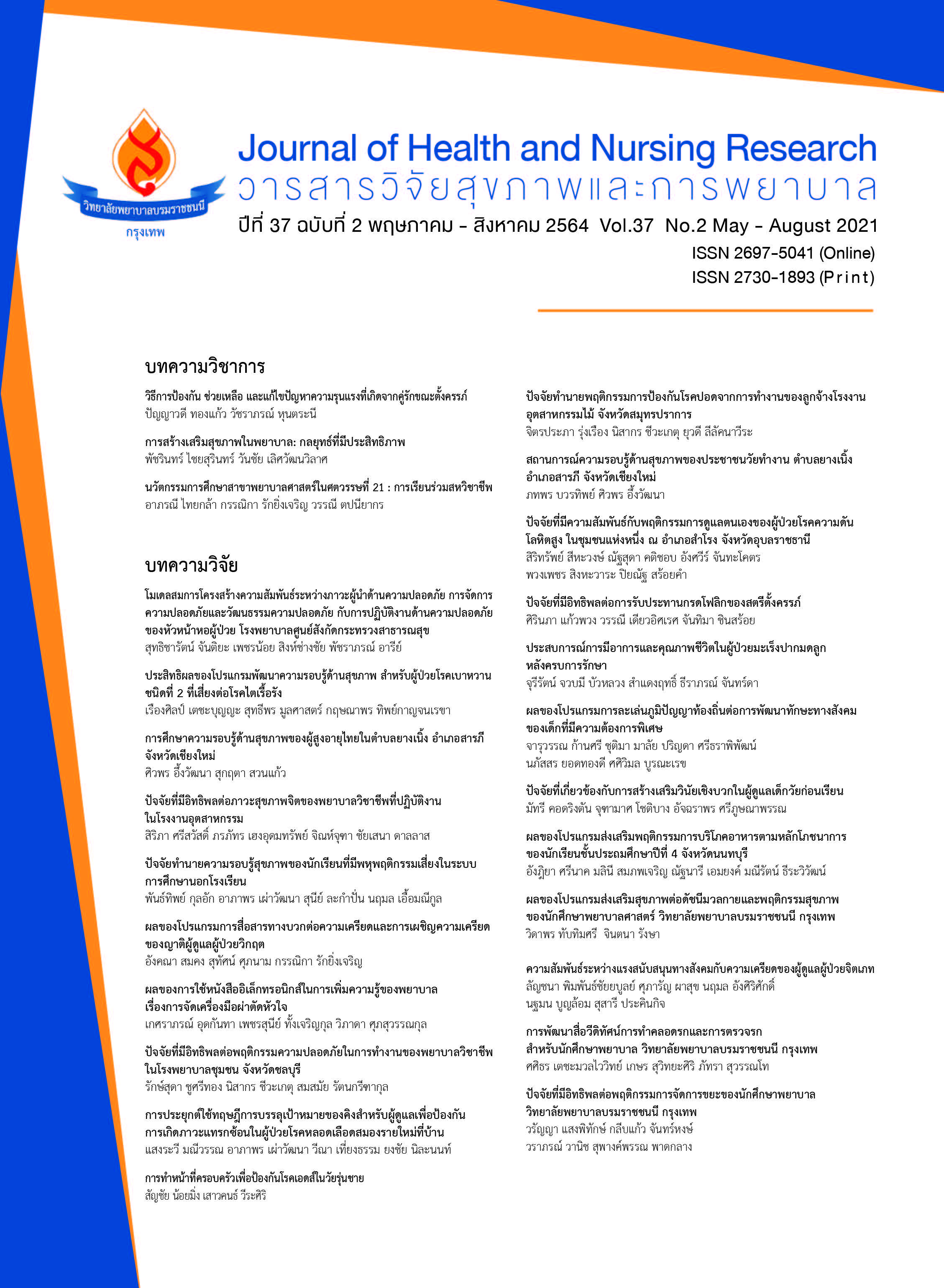ผลของโปรแกรมส่งเสริมสุขภาพต่อดัชนีมวลกายและพฤติกรรมสุขภาพของนักศึกษาพยาบาลศาสตร์ วิทยาลัยพยาบาลบรมราชชนนี กรุงเทพ
คำสำคัญ:
คำสำคัญ :ส่งเสริมสุขภาพ, ดัชนีมวลกาย, พฤติกรรมสุขภาพ, นักศึกษาพยาบาลบทคัดย่อ
บทนำ: การส่งเสริมสุขภาพมีประโยชน์ต่อผู้เข้าร่วมเมื่อได้รับคำแนะนำตามทฤษฎีทางสังคมและพฤติกรรมศาสตร์และทำให้เกิดการเปลี่ยนแปลงพฤติกรรมสุขภาพไปในทางที่ดี วัตถุประสงค์การวิจัย: เพื่อศึกษาผลของโปรแกรมส่งเสริมสุขภาพต่อดัชนีมวลกายและพฤติกรรมสุขภาพของนักศึกษาพยาบาลศาสตร์ วิทยาลัยพยาบาลบรมราชชนนี กรุงเทพ ระเบียบวิธีวิจัย: การศึกษาครั้งนี้เป็นการวิจัยแบบกึ่งทดลอง (quasi-experimental research) ชนิดสองกลุ่มวัดก่อนและหลังการทดลอง (two group pretest-posttest design) ตั้งแต่เดือนมีนาคม พ.ศ. 2562 ถึง กันยายน พ.ศ. 2563 เลือกกลุ่มตัวอย่างแบบเฉพาะเจาะจง โดยคัดเลือกนักศึกษาที่มีค่าดัชนีมวลกาย (BMI) มากกว่า 22.9 จำนวน 60 คน แบ่งเป็นกลุ่มทดลองและกลุ่มควบคุม กลุ่มละ 30 คน ที่มีคุณลักษณะไม่แตกต่างกัน กลุ่มทดลองได้รับโปรแกรมการส่งเสริมสุขภาพที่ได้ประยุกต์จากแนวคิดของเพนเดอร์ ได้แก่ การสร้างแรงบันดาลใจ การให้ความรู้เกี่ยวกับการส่งเสริมสุขภาพ อาหารสุขภาพ การออกกำลังกาย การจัดการกับความเครียด และการสนทนากลุ่ม เครื่องมือที่ใช้เป็นแบบสอบถามข้อมูลพฤติกรรมการส่งเสริมสุขภาพจำนวน 45 ข้อ ได้ค่าดัชนีความสอดคล้องเท่ากับ 0.94 และค่าความเชื่อมั่นเท่ากับ 0.81 เก็บรวบรวมข้อมูลโดยใช้แบบสอบถามข้อมูลทั่วไปและพฤติกรรมส่งเสริมสุขภาพ วิเคราะห์ข้อมูลโดยใช้สถิติที (Paired t-test และ Independent t-test) ผลการวิจัย: พบว่ากลุ่มตัวอย่างทั้งกลุ่มทดลองและควบคุมก่อนการทดลอง มีค่าเฉลี่ยคะแนนพฤติกรรมการส่งเสริมสุขภาพ (mean= 164.13, SD.= 13.17 และ mean= 164.83, SD.= 11.94) และค่าเฉลี่ยดัชนีมวลกาย ( = 26.46, SD.= 4.63 และ mean = 26.93, SD.= 3.36) ตามลำดับ โดยทั้ง 2 ตัวแปรไม่แตกต่างกันอย่างมีนัยสำคัญ ส่วนหลังการทดลองพบว่ากลุ่มทดลองมีค่าเฉลี่ยคะแนนพฤติกรรมการส่งเสริมสุขภาพในภาพรวมทั้งหมด (mean =183.80, SD=13.17) สูงกว่ากลุ่มควบคุม (mean = 170.20, SD.= 11.94) อย่างมีนัยสำคัญทางสถิติที่ระดับ .001 (t = 3.45, p <.001) และกลุ่มทดลองมีค่าเฉลี่ยดัชนีมวลกาย (mean = 25.28, SD.= 4.06) น้อยกว่ากลุ่มควบคุม (mean =27.53, SD.=3.47) อย่างมีนัยสำคัญทางสถิติที่ระดับ.05 (t= 2.30, p= .02) สรุปผล: การศึกษาครั้งนี้สนับสนุนว่าโปรแกรมส่งเสริมสุขภาพ ช่วยให้นักศึกษาพยาบาลมีพฤติกรรมสุขภาพดี และค่าดัชนีมวลกายดีขึ้น ข้อเสนอแนะ: ควรนำโปรแกรมการส่งเสริมสุขภาพนี้ไปใช้กับนักศึกษาพยาบาลหรือประยุกต์ใช้ให้เหมาะสมกับบริบทของแต่ละบุคคลอย่างต่อเนื่องทุกปี เพื่อเป็นการส่งเสริมสุขภาพให้ดียิ่งขึ้น
Downloads
เอกสารอ้างอิง
Executive Committee for the Formulation of the National Health Development Plan, Ministry of Public Health. National health development plan issue 12 (2017 - 2021). The War Veterans Organization of Thailand. October 2016; (in Thai)
Sakolsatayathorn, P. Looking at the future of Thai health in 2018 with changing public health policies. [internet]. 2018 (cited 2019 Dec 25); Available from: https://www.matichon.co.th/local/quality-life/news_786690. (in Thai)
World Health Organization (WHO). Noncommunicable diseases. [internet]. 2018 (cited 2019 Dec 25); Available from: https://www.who.int/news-room/fact-sheets/detail/noncommunicablediseases
Danyuthasilpe C. Pender’s health promotion model and its applications in nursing practice. Songklanagarind J Nurs.. 2018;38(2):132-41. (in Thai).
Lattanand K, Ninwatcharamanee C. Health literacy of nursing students at Boromarajonani College of Nursing Bangkok. JHNR 2019; 35(1):277-89. (in Thai)
Pender NJ, Murdaugh CL, Parsons MA. Health promotion in nursing practice. 4th (ed). New Jersey :
Pearson Education, Inc; 2002.
Committee of department of health. Handbook of good health. [internet]. 2020 (cited 2020 Aug 26); Available from: http://nutrition.anamai.moph.go.th/images/files/pdf
Purakom A, Kaewmahingsa Y. Health promoting behaviors of undergraduate students at Kasetsart University, Kamphaengsaen Campus National Symposium Kasetsart University Kamphaeng Saen Campus No. 10; 2013. (in Thai)
Wiersma EW, Jurs SG. Research methods in education: An introduction, 8th Edition. 2002.
Danyuthasilpe C. Pender’s health promotion model and its applications in nursing practice. Songklanagarind J Nurs. 2018;38(2):132-41. (in Thai)
Khodaveisi M, Jafari A, Omidi A, Roshanaei G, Sazvar A. the effect of a Pender’s health promotion model based educational intervention on physical activity in office staff. [internet]. 2020 (cited 2020 Aug 26); Available from: https://nursinganswers.net/essays/penders-health-promotionmodel. php?vref=1
Khodaveisi M, Omidi A, Farokhi S, Soltanian AR. The effect of Pender’s health promotion model in improving the nutritional behavior of overweight and obese women. IJCBNM. 2017 Apr; 5(2):165–74.
Heetaksorn C, Sarakshetrin A, Kwanchum R, Yuychim Y. The effects of using a health promotion program among sellers at the Kobkhan Fresh Market in Suratthani, Thailand The Southern College Network. JNPH 2017;s:91-101.
Khampeng S, Boonpradit A. The effects of using health promotion program and social support among people with hypertension in Donpud District, Saraburi Province, Thailand Nursing. NJPH 2012;22(3):112-23. (in Thai)
Songwatthanayuth P, Watthanakorn K, Klainhom K, Ratanapak P. Development of health behavior promotion program among pre-hypertension adults in Nong-Plub, Phetchaburi Province. JHNR 2016;32(2):105-18. (in Thai)
ดาวน์โหลด
เผยแพร่แล้ว
รูปแบบการอ้างอิง
ฉบับ
ประเภทบทความ
สัญญาอนุญาต
บทความที่ได้รับการตีพิมพ์ เป็นลิขสิทธิ์ของวารสารวิจัยสุขภาพและการพยาบาล (วิทยาลัยพยาบาลบรมราชชนนี กรุงเทพ) ไม่สามารถนำไปตีพิมพ์ซ้ำในวารสารฉบับอื่น


















